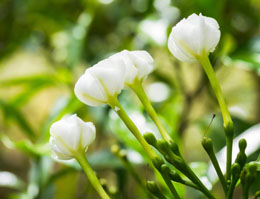Sampaguita is a national flower of two countries, Indonesia and the Philippines. Know what is the meaning of this flower, in this article.

Sampaguita plant is native to southern Asian countries of India, Sri Lanka and Myanmar. Besides, it is grown in most tropical countries and some parts of China as well as South Pacific regions. It has gained a status of national flower in Indonesia and the Philippines. This flower belongs to the jasmine family and exudes the characteristic rich fragrance peculiar to this genus. It is a small white flower which grows on a climbing plant. Sampaguita can grow in almost any soil as long as it receives sunlight and warm weather. Let us delve deeper into the meaning of the Sampaguita flower.
Sampaguita Flower Meaning
Sampaguita is an evergreen shrub with ovate leaves and bearing oval petaled flowers. The petals are arranged in a single layer or double layers. This flower has a characteristic rich fragrance. Sampaguita is cultivated as an ornamental flower in many countries, however, its presence is more dominant in South Asian countries. Sampaguita is actually a Spanish term which originates from Filipino words
sumpa kita, meaning 'I promise you'. Needless to say, this flower has become a symbol of love, purity, devotion, dedication, strength and fidelity. In earlier times, Sampaguita garlands were exchanged by couples in love as a pledge of their commitment, similar to the exchange of wedding rings.
As mentioned above, Sampaguita flower belongs to the family of jasmine and exhibits many of the characteristics of this family. Let us look at its classification in detail.
Kingdom:
Plantae
Division:
Magnoliophyta
Class:
Magnoliopsida
Order:
Lamiales
Family:
Oleaceae
Genus:
Jasminum
Species:
sambac
Uses of Sampaguita
Sampaguita flower is very versatile and finds its use in many fields. The first and the foremost use of this flower is as a perfuming agent. Due to its rich fragrance, it is used in many cosmetic products and essential oils. Oil extracted for the flower is used in skin creams, lotions, deodorants, perfumes, hair oils etc. It is also widely used for adorning hair in South Asian countries. Other uses of Sampaguita include, decoration of venues during religious ceremonies such as weddings. It is considered as a very auspicious flower, hence, is greatly sought after during such ceremonies. In some countries it is customary to welcome guests with garlands of Sampaguita. Sampaguita flower also has tremendous medicinal properties. It is widely used for making herbal medicines to treat headaches, fever, cough, diarrhea and abdominal pain. The petals of this flower are used for making herbal tea, whereas, its roots are ground to make a remedy for snakebites. It is also beneficial for healing cuts and wounds.
Sampaguita Cultivation
Sampaguita needs ample sunlight and water to grow. Although, it can thrive in any kind of soil, it particularly flourishes in soil that has been enriched with organic matter or farmyard compost. The mode of propagation of the flower is cutting, as it fails to produce fruits with viable seeds. You may plant it in a pot or a plastic container. However, as the plant grows, you may have to support it with props, as it is essentially a climbing plant. The soil must be kept moist at all times. It is important to water the plant at least once a day. However, avoid flooding the pot with water, as it may cause rotting of the roots. The plant must be pruned regularly after a blooming season to boost its growth and maintain its size.
Sampaguita can be a great addition in your garden, provided you have all the growth factors in place. The fresh flowers can be used to adorn your home during special occasions.






 Sampaguita plant is native to southern Asian countries of India, Sri Lanka and Myanmar. Besides, it is grown in most tropical countries and some parts of China as well as South Pacific regions. It has gained a status of national flower in Indonesia and the Philippines. This flower belongs to the jasmine family and exudes the characteristic rich fragrance peculiar to this genus. It is a small white flower which grows on a climbing plant. Sampaguita can grow in almost any soil as long as it receives sunlight and warm weather. Let us delve deeper into the meaning of the Sampaguita flower.
Sampaguita plant is native to southern Asian countries of India, Sri Lanka and Myanmar. Besides, it is grown in most tropical countries and some parts of China as well as South Pacific regions. It has gained a status of national flower in Indonesia and the Philippines. This flower belongs to the jasmine family and exudes the characteristic rich fragrance peculiar to this genus. It is a small white flower which grows on a climbing plant. Sampaguita can grow in almost any soil as long as it receives sunlight and warm weather. Let us delve deeper into the meaning of the Sampaguita flower.